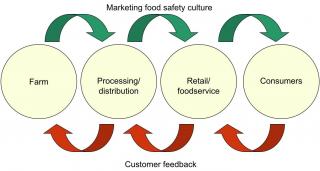
If providing safe food is a priority, why do large outbreaks of foodborne illness keep happening? Incidents like 2010’s salmonella-in-eggs outbreak sickened more than 1,900 across the U.S. and led to the recall of 500 million eggs.
A new study by a Kansas State University professor and colleagues finds how the culture of food safety is practiced within an organization can be a significant risk factor in foodborne illness.
Doug Powell, associate professor of food safety at K-State, said how businesses and organizations operate above and beyond minimal food safety .jpg) regulations and inspections, or their food safety culture, is often overlooked.
regulations and inspections, or their food safety culture, is often overlooked.
"You’d think making customers sick is bad for business, yet some firms go out of their way to ignore food safety," Powell said. "Some places are motivated by money and efficiencies. The amount of regulation, inspection and audits just doesn’t seem to matter. And those ‘Employees Must Wash Hands’ signs don’t really work."
Powell, along with Casey Jacob, a former K-State research assistant, and Ben Chapman, an assistant professor at North Carolina State University, examined three food safety failures: an E. coli O157:H7 outbreak in Wales in 2005 that sickened 157 and killed one; a listeria outbreak in Canada in 2008 that sickened 57 and killed 23; and a salmonella outbreak in the U.S. in 2009 linked to peanut paste that killed nine and sickened 691.
Their study "Enhancing Food Safety Culture to Reduce Rates of Foodborne Illness" is being published by the journal Food Control and is available in advance online at http://bit.ly/hDh9EE.
"Creating a culture of food safety requires application of the best science with the best management and communication systems," Chapman said. "Operators should know the risks associated with their products, how to manage them, and most important, how to communicate with and compel their staff to employ good practices — it’s a package deal."
According to the researchers, individuals focusing on food safety risks within an organization with a good food safety culture do the following:
* know the risks associated with the foods they handle and how those should be managed;
* dedicate resources to evaluate supplier practices;
* stay up-to-date on emerging food safety issues;
* foster a value system within the organization that focuses on avoiding illnesses;
* communicate compelling and relevant messages about risk reduction activities, and empower others to put them into practice;
* promote effective food safety systems before an incident occurs; and,
• don’t blame customers, including commercial buyers and consumers, when illnesses are linked to their products.
Source: Doug Powell, 785-317-0560, dpowell@k-state.edu


(1).jpg) However, it remains a challenge to compel food producers, processors, distributors, retailers, foodservice outlets and home meal preparers to adopt scientifically validated safe food handling behaviors, especially in the absence of an outbreak.
However, it remains a challenge to compel food producers, processors, distributors, retailers, foodservice outlets and home meal preparers to adopt scientifically validated safe food handling behaviors, especially in the absence of an outbreak. • stay up-to-date on emerging food safety issues;
• stay up-to-date on emerging food safety issues;.jpg) encouragement and enforcement to foster a food safety culture; and use technology to be transparent – whether it’s live webcams in the facility or real-time test results on the website – to help restore the shattered trust with the buying public.
encouragement and enforcement to foster a food safety culture; and use technology to be transparent – whether it’s live webcams in the facility or real-time test results on the website – to help restore the shattered trust with the buying public.(1)(1).jpg) demonstrable way. In an organization with a good food safety culture, individuals are expected to enact practices that represent the shared value system and point out where others may fail. By using a variety of tools, consequences and incentives, businesses can demonstrate to their staff and customers that they are aware of current food safety issues, that they can learn from others’ mistakes, and that food safety is important within the organization. The three case studies presented in this paper demonstrate that creating a culture of food safety requires application of the best science with the best management and communication systems, including compelling, rapid, relevant, reliable and repeated food safety messages using multiple media.
demonstrable way. In an organization with a good food safety culture, individuals are expected to enact practices that represent the shared value system and point out where others may fail. By using a variety of tools, consequences and incentives, businesses can demonstrate to their staff and customers that they are aware of current food safety issues, that they can learn from others’ mistakes, and that food safety is important within the organization. The three case studies presented in this paper demonstrate that creating a culture of food safety requires application of the best science with the best management and communication systems, including compelling, rapid, relevant, reliable and repeated food safety messages using multiple media.